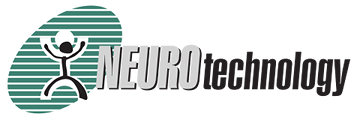Press Release
VeriLook Surveillance 3.0 SDK Identifies Faces and Moving Objects, Differentiates Pedestrians from Other Moving Objects in Video Surveillance Systems
Smart monitoring algorithm for video surveillance provides biometric facial identification, identifies whether subjects in motion are people or objects and detects when defined borders have been crossed, triggering alerts in law enforcement and security monitoring systems.
Vilnius, Lithuania – October 15, 2014 – Neurotechnology, a provider of high-precision biometric identification technologies, today announced the availability of the VeriLook Surveillance 3.0 software development kit (SDK). VeriLook Surveillance 3.0 provides real-time biometric face identification using live video streams from single or multiple high-resolution digital surveillance cameras. The new version not only identifies faces in a crowd, it detects and differentiates people from objects while they are moving through the video frame. It can also detect if a person or object is entering or leaving a predefined boundary area, triggering an alert to the system monitor. This smart monitoring technology can be used for a variety of applications, including retail and commercial areas, entrance monitoring and counting, automated time-attendance systems, transportation, law enforcement and security systems.
VeriLook Surveillance 3.0 includes a robust, dynamic face model that can adapt to visual appearance changes as subjects move across the scene. Based on the latest biometric facial recognition engine from Neurotechnology's MegaMatcher 5.0 line (VeriLook 5.5), VeriLook Surveillance 3.0 provides even faster face detection, improved face feature determination and emotion detection, including detection of smiles, closed-eyes, open-mouths, clear glasses and dark glasses. VeriLook Surveillance 3.0 matches face images against internal databases, such as authorized personnel or criminal watch lists, after which a VeriLook Surveillance-based application can then lock or unlock a door, put a record into a time/attendance system or immediately trigger a report or alert for recognized (or un-recognized) faces.
In situations when video surveillance is monitoring a very large area or when cameras are in a position such that captured faces are too small for recognition or not visible, VeriLook Surveillance uses moving object detection and classification to identify objects vs. people in the scene. If a moving person or object has crossed a defined border or entered/left a specific monitored area or region, VeriLook Surveillance can send an immediate alert notification and trigger appropriate action if a restricted or sensitive area has been compromised. This ability to detect and track both moving people and objects allows VeriLook Surveillance to be used in a much wider range of applications, such as event security or police applications like the automatic detection of vehicles passing through red lights or stop signs.
"In this release of VeriLook Surveillance we have introduced new features, such as pedestrian detection, security zones and moving object tracking, all of which increase the flexibility of our product and allow our customers to apply it in many new and different ways," said Dr. Raimond Laptik, surveillance research lead for Neurotechnology.
VeriLook Surveillance 3.0 continues tracking of subjects even when their faces briefly disappear from the frame or when they are partially blocked by other objects or even other faces (a common problem while tracking multiple faces). The face recognition algorithm enables detection of faces with up to 45 degrees out-of-plane rotation in yaw angle and uses motion prediction models to re-localize faces that have undergone full occlusion, such as when a subject has been fully obstructed by a wall and emerged on the other side. The dynamic face model allows the system to efficiently and reliably track faces in front of complex backgrounds and ensures that subjects can be localized in all video frames, even under strenuous conditions.
VeriLook Surveillance 3.0 enables one computer to process images from several cameras and also provides connections between VeriLook Surveillance units deployed on different computers, synchronizing the databases so that the system works as a whole within the logical network. It enables real-time face detection, extraction and matching by providing parallelization of VeriLook functions for improved performance on multi-core, multi-processor systems.
The VeriLook Surveillance 3.0 SDK is available through Neurotechnology or from distributors worldwide. For more information, go to: www.neurotechnology.com.
About Neurotechnology
Neurotechnology is a provider of high-precision biometric fingerprint, face, iris, palmprint and voice identification algorithms, object recognition technology and software development products. More than 2500 system integrators, security companies and hardware providers integrate Neurotechnology's algorithms into their products, with millions of customer installations worldwide.
Neurotechnology's identification algorithms have consistently earned the highest honors in some of the industry's most rigorous competitions, including the National Institute of Standards and Technology (NIST)'s Fingerprint Vendor Technology Evaluation (FpVTE), the Minutiae Interoperability Exchange Test (MINEX), the Iris Exchange (IREX) and the Fingerprint Verification Competitions (FVC).
Drawing from years of academic research in the fields of neuroinformatics, image processing and pattern recognition, Neurotechnology was founded in 1990 in Vilnius, Lithuania and released its first fingerprint identification system in 1991. Since that time the company has released more than 80 products and version upgrades for identification and verification of objects and personal identity.
Media Contact
Jennifer Allen Newton
Bluehouse Consulting Group, Inc.
+1-503-805-7540
jennifer (at) bluehousecg (dot) com
